Charles E W Bean, Diaries, AWM38 3DRL 606/243A/1 - 1916 - 1934 - Part 26
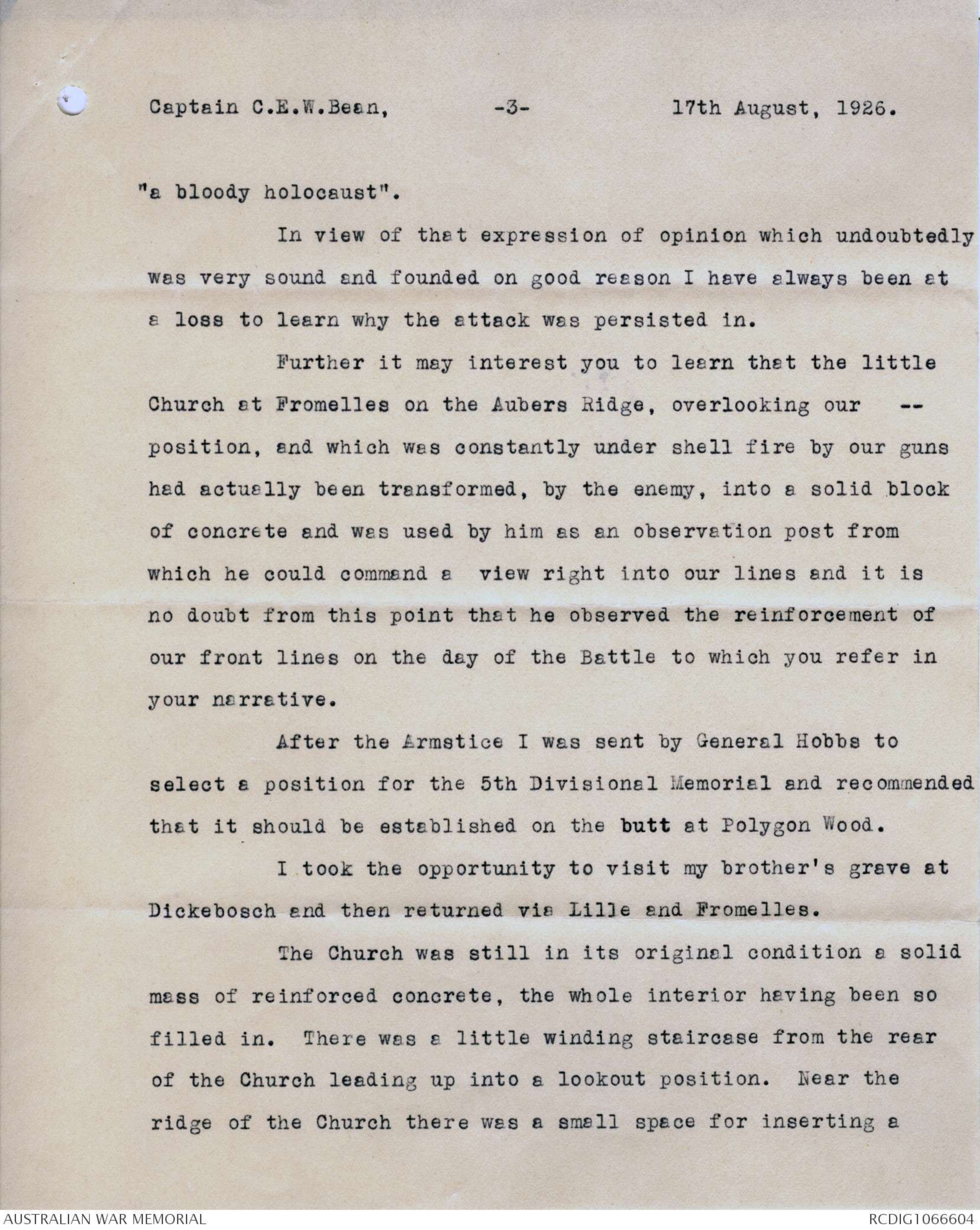
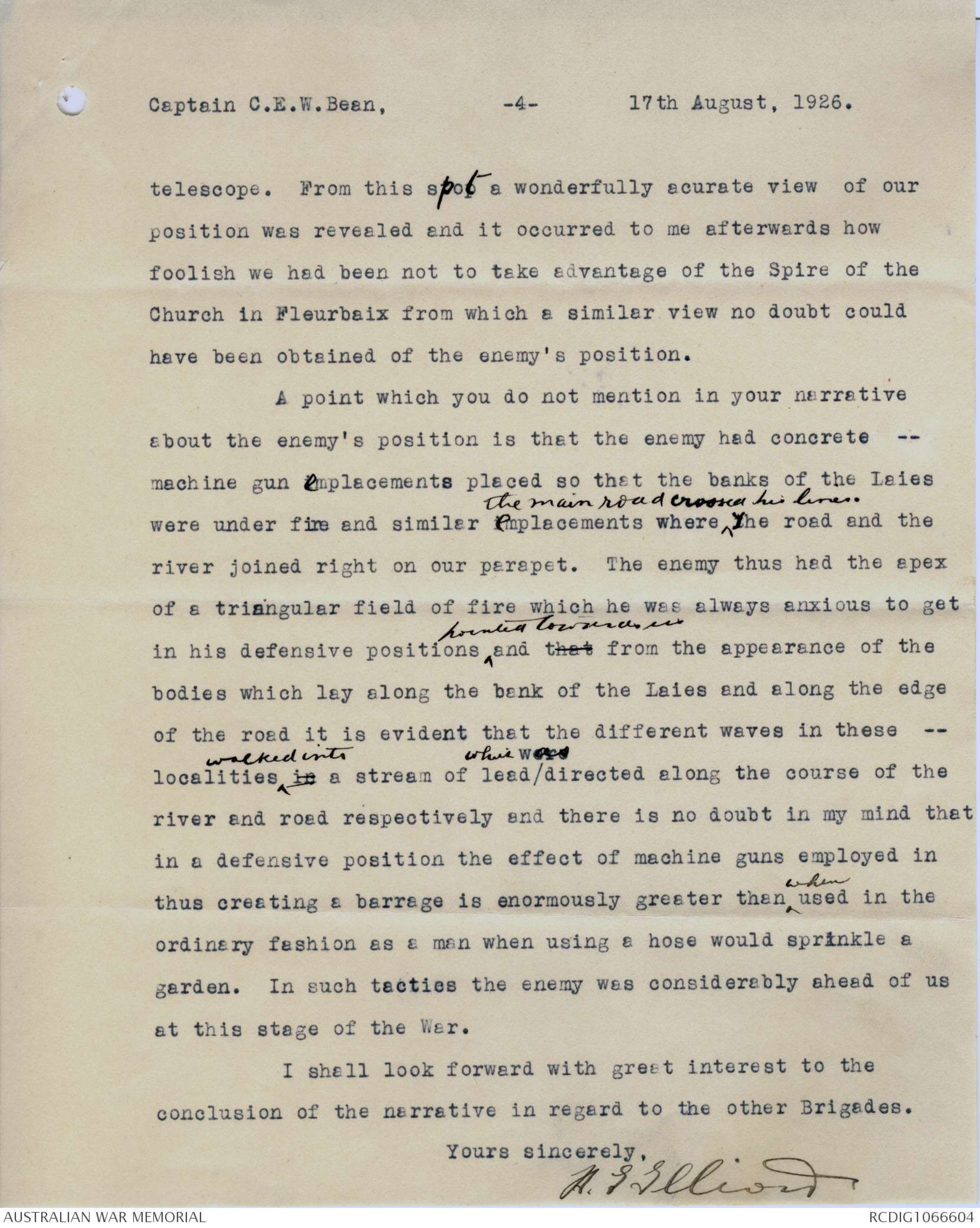
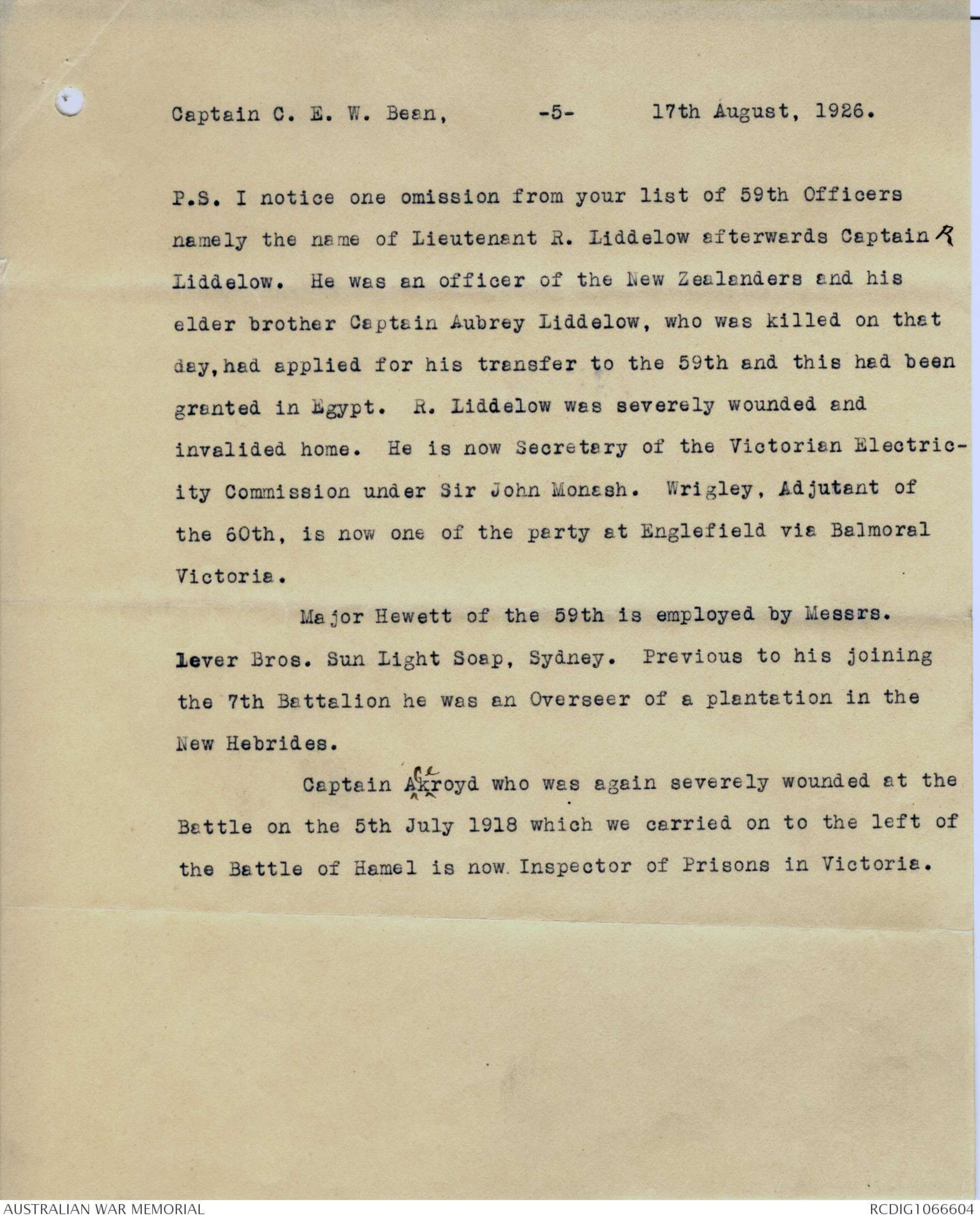
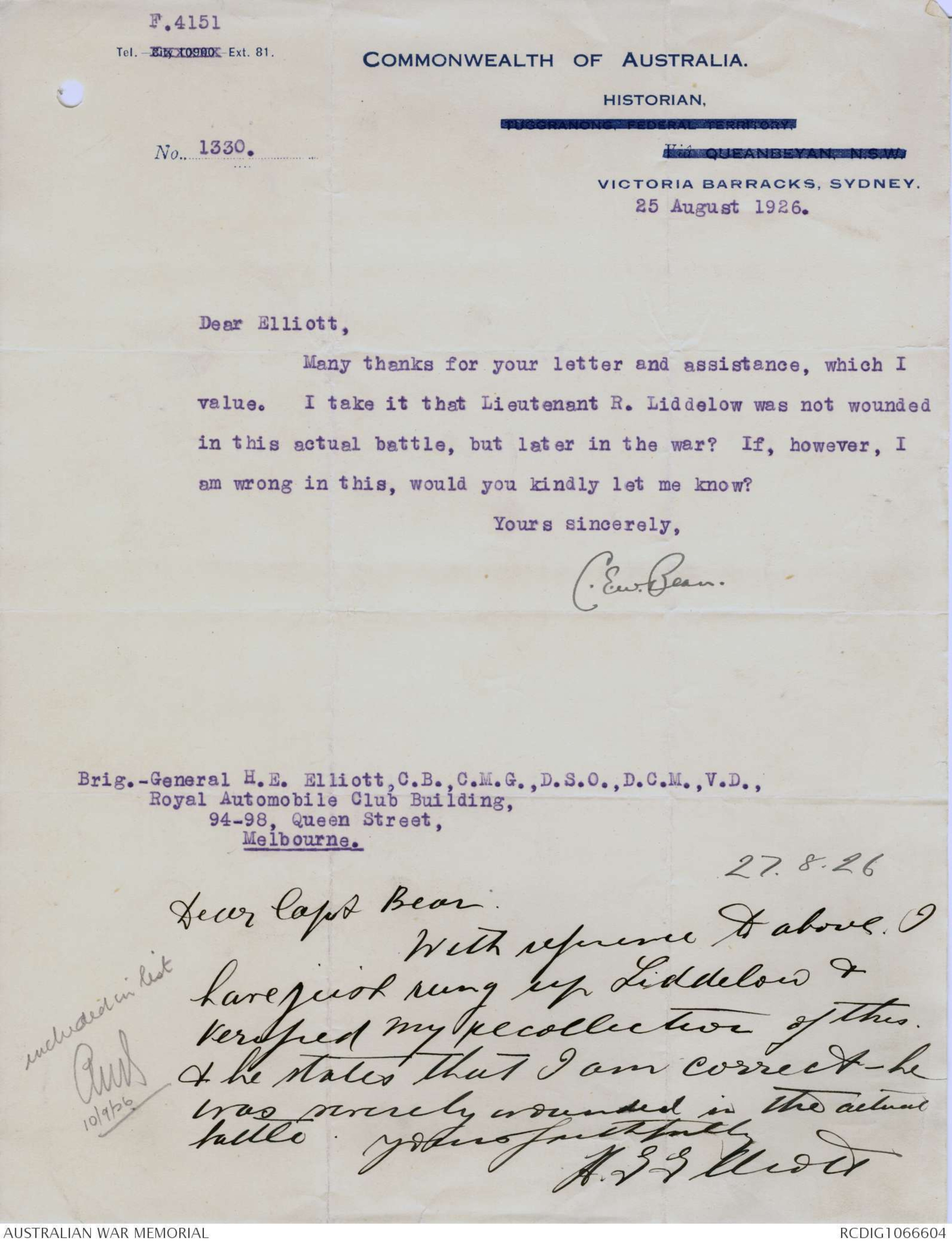
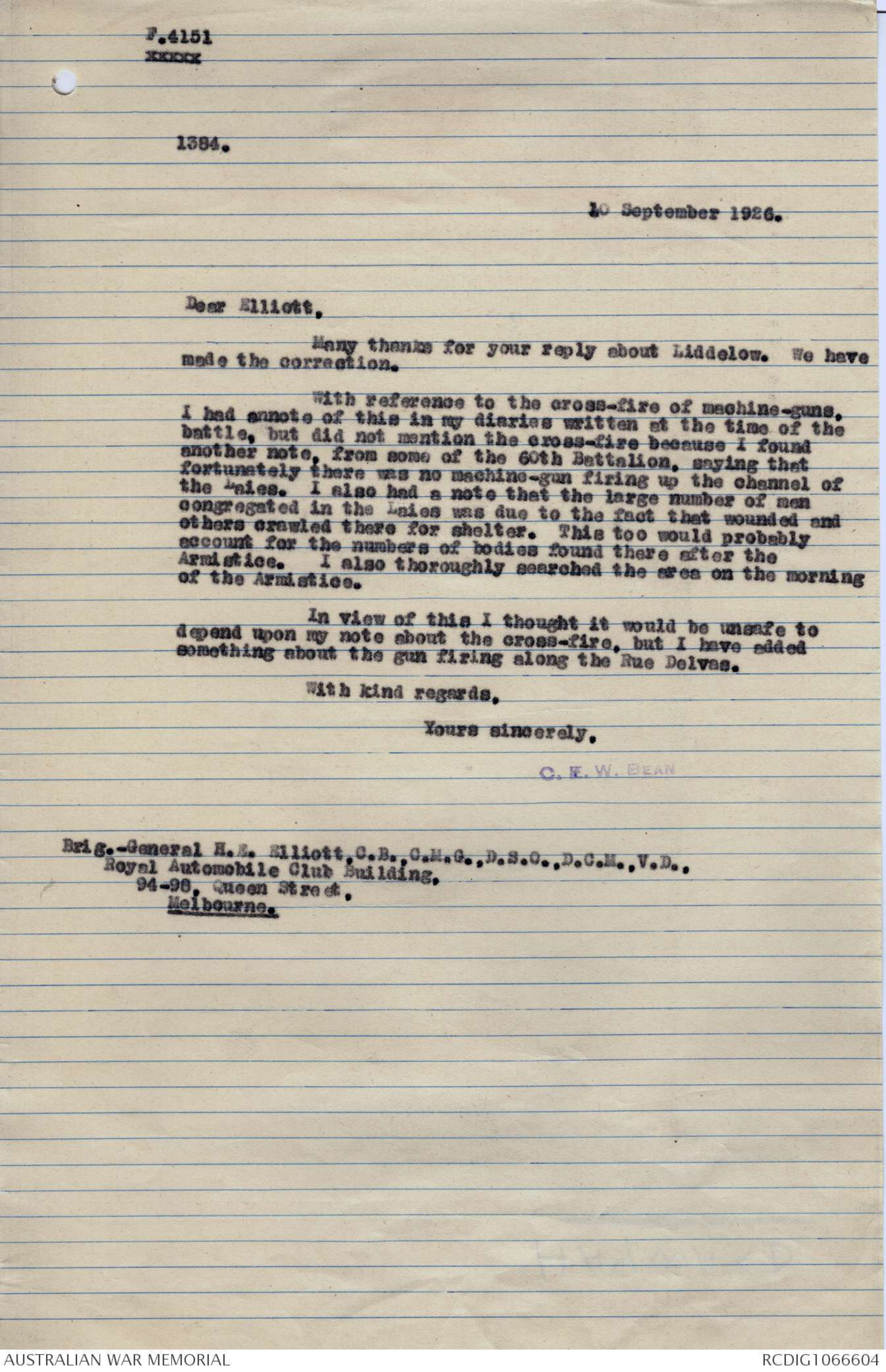
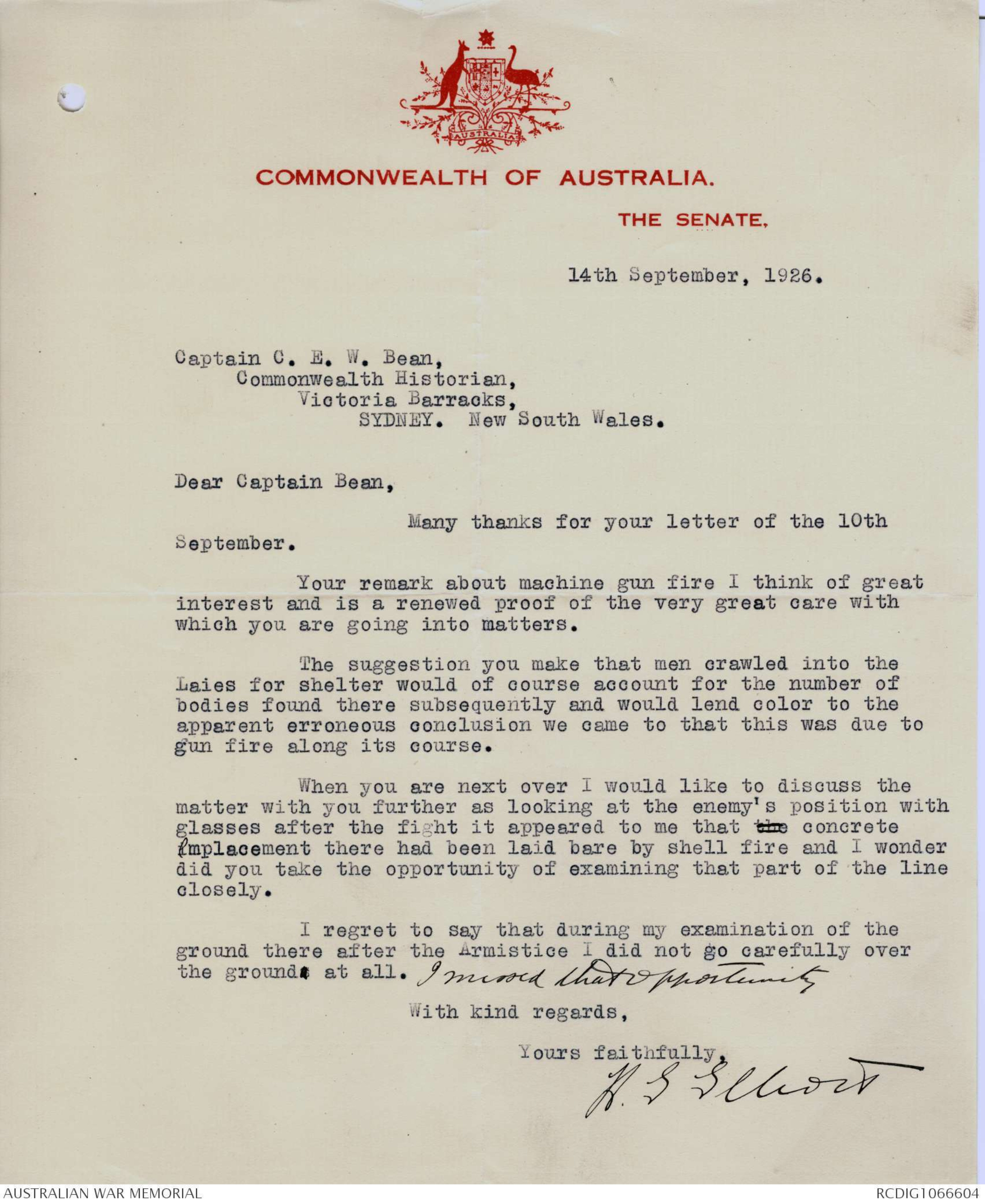
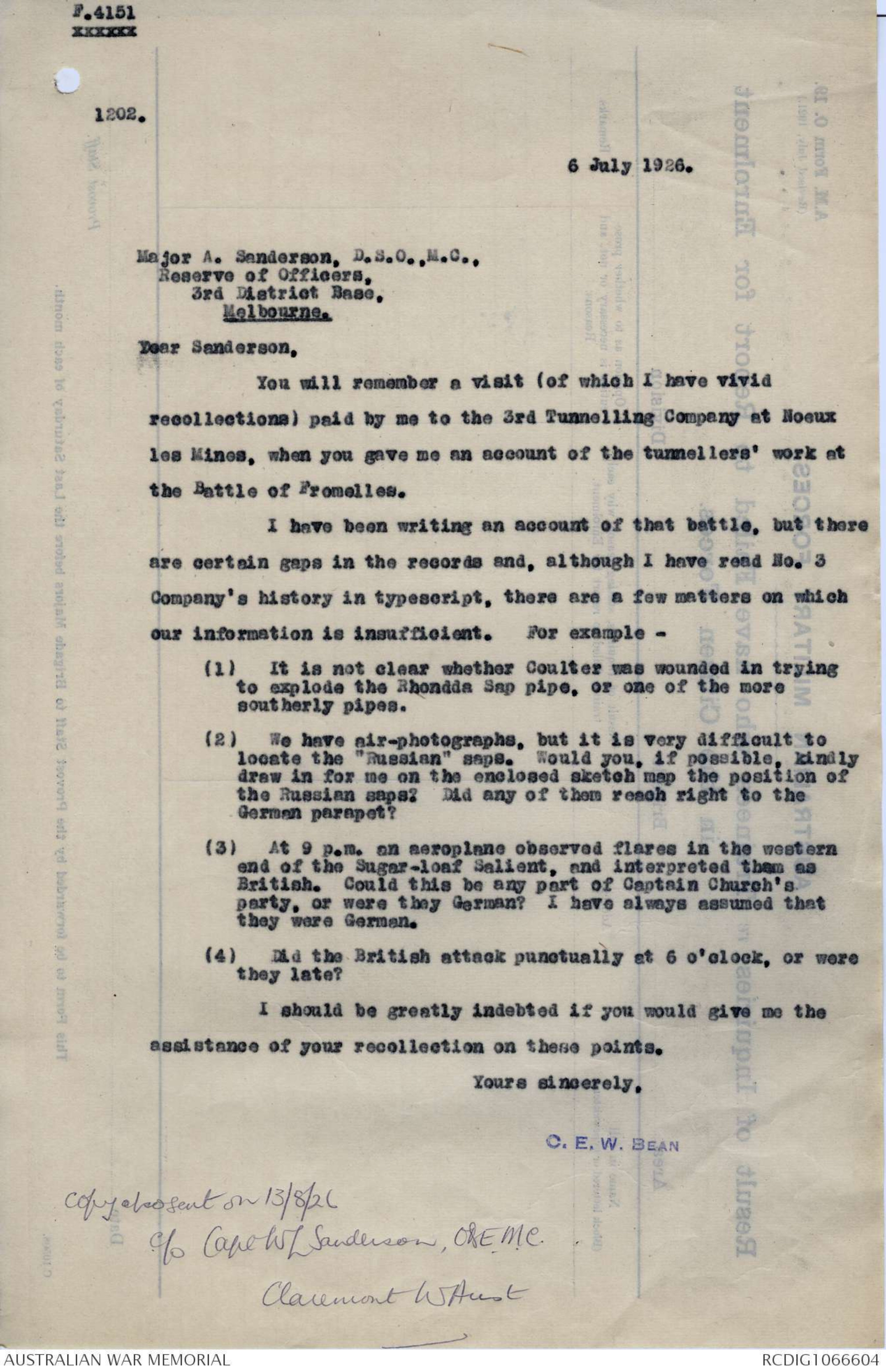
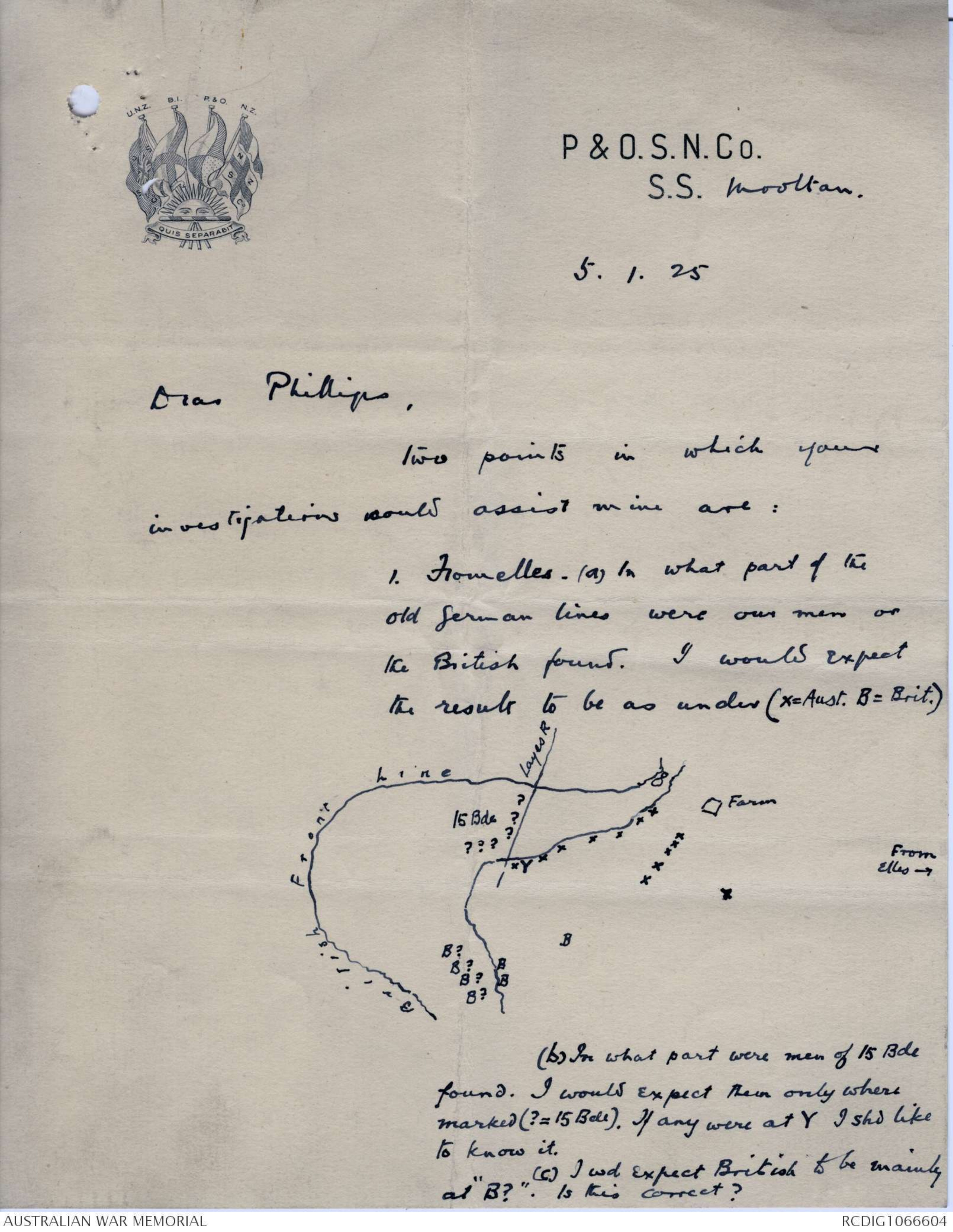
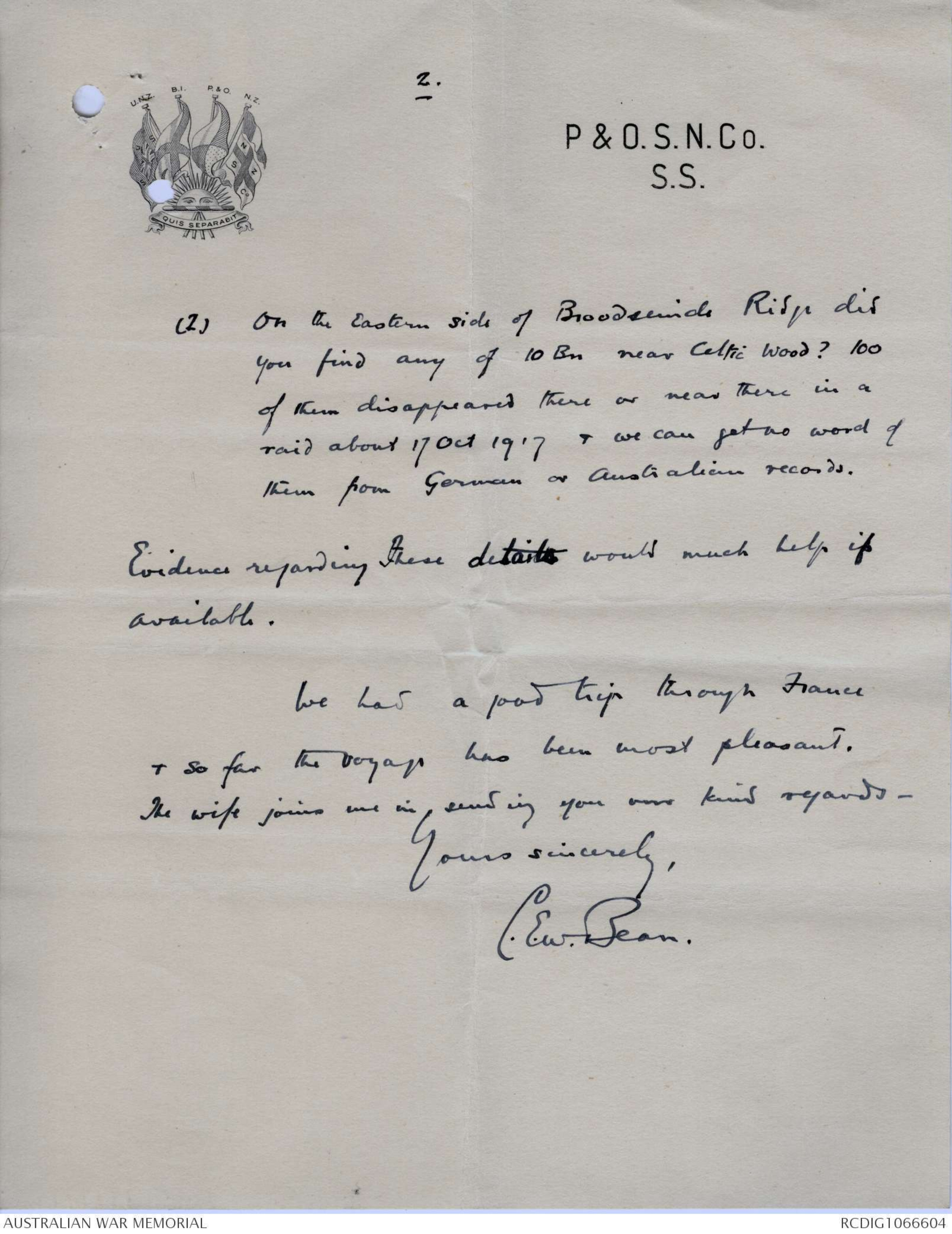
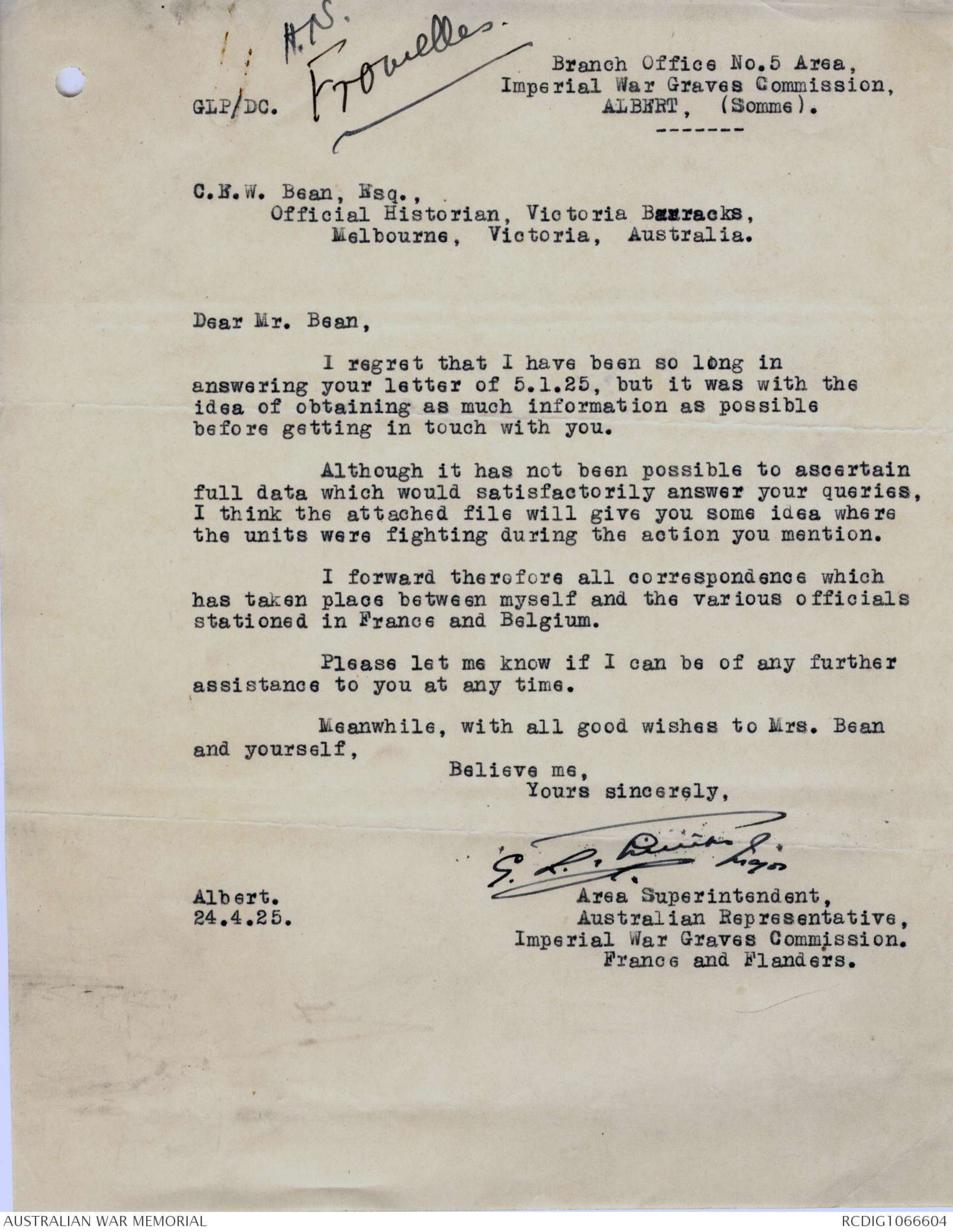
-3-
Captain C.E.W. Bean, 17th August, 1926.
"a bloody holocaust".
In view of that expression of opinion which undoubtedly
was very sound and founded on good reason I have always been at
a loss to learn why the attack was persisted in.
Further it may interest you to learn that the little
Church at Fromelles on the Aubers Ridge, overlooking our --
position, and which was constantly under shell fire by our guns
had actually been transformed, by the enemy, into a solid block
of concrete and was used by him as an observation post from
which he could command a view right into our lines and it is
no doubt from this point that he observed the reinforcement of
our front lines on the day of the Battle to which you refer in
your narrative.
After the Armistice I was sent by General Hobbs to
select a position for the 5th Divisional Memorial and recommended
that it should be established on the butt at Polygon Wood.
I took the opportunity to visit my brother's grave at
Dickebosch and then returned via Lille and Fromelles.
The Church was still in its original condition a solid
mass of reinforced concrete, the whole interior having been so
filled in. There was a little winding staircase from the rear
of the Church leading up into a lookout position. Near the
ridge of the Church there was a small space for inserting a
-4-
Captain C.E.W. Bean, 17th August, 1926.
telescope. From this spot a wonderfully acurate view of our
position was revealed and it occurred to me afterwards how
foolish we had been not to take advantage of the Spire of the
Church in Fleurbaix from which a similar view no doubt could
have been obtained of the enemy's position.
A point which you do not mention in your narrative
about the enemy's position is that the enemy had concrete --
machine gun emplacements placed so that the banks of the Laies
were under fire and similar emplacements where ^the main road crossed his lines. The road and the
river joined right on our parapet. The enemy thus had the apex
of a triangular field of fire which he was always anxious to get
in his defensive positions ^pointed towards us and that from the appearance of the
bodies which lay along the bank of the Laies and along the edge
of the road it is evident that the different waves in these --
localities ^walked into in a stream of lead ^which were was directed along the course of the
river and road respectively and there is no doubt in my mind that
in a defensive position the effect of machine guns employed in
thus creating a barrage is enormously greater than ^when used in the
ordinary fashion as a man when using a hose would sprinkle a
garden. In such tactics the enemy was considerably ahead of us
at this stage of the War.
I shall look forward with great interest to the
conclusion of the narrative in regard to the other Brigades.
Yours sincerely,
H.E. Elliott
-5-
Captain C.E.W. Bean, 17th August, 1926.
P.S. I notice one omission from your list of 59th Officers
namely the name of Lieutenant R. Liddlelow afterwards Captain R
Liddelow. He was an officer of the New Zealanders and his
elder brother Captain Aubrey Liddlelow, who was killed on that
day, had applied for his transfer to the 59th and this had been
granted in Egypt. R. Liddlelow was severely wounded and
invalided home. He is now Secretary of the Victorian Electricity
Commission under Sir John Monash. Wrigley, Adjutant of
the 60th, is now one of the party at Englefield via Balmoral
Victoria.
Major Hewett of the 59th is employed by Messrs.
Lever Bros. Sun Light Soap, Sydney. Previous to his joining
the 7th Battalion he was an Overseer of a plantation in the
New Hebrides.
Captain A^ck^royd who was again severely wounded at the
Battle on the 5th July, 1918 which we carried on to the left of
the Battle of Hamel is now Inspector of Prisons in Victoria.
F.4151
Tel. - City 10900 Ext 81
COMMONWEALTH OF AUSTRALIA.
HISTORIAN.TUGGRANONG, FEDERAL TERRITORYVia QUEANBEYAN, N.S.W.
No 1330.
VICTORIA BARRACKS, SYDNEY.
25 August 1926.
Dear Elliott,
Many thanks for your letter and assistance, which I
value. I take it that Lieutenant R. Liddelow was not wounded
in this actual battle, but later in the war? If, however, I
am wrong in this, would you kindly let me know?
Yours sincerely,
C.E.W. Bean.
Brig.-General H.E. Elliott, C.B., C.M.G., D.S.O., D.C.M., V.D.,
Royal Automobile Club Building,
94-98, Queen Street,
Melbourne.
27.8.26
Dear Capt Bean
[*included in list
AWB
10/9/26*]
[*With reference to above. I
have just rung up Liddelow &
verified my recollection of this
& he states that I am correct - he
was severely wounded in the actual
battle.
Yours faithfully
H.E. Elliott*]
F.4151
xxxxx
1384.
10 September 1926.
Dear Elliott,
Many thanks for your reply about Liddelow. We have
made the correction.
With reference to the cross-fire of machine-guns,
I had annote of this in my diaries written at the time of the
battle, but did not mention the cross-fire because I found
another note, from some of the 60th Battalion, saying that
fortunately there was no machine-gun firing up the channel of
the Laies. I also had a note that the large number of men
congregated in the Laies was due to the fact that wounded and
others crawled there for shelter. This too would probably
account for the numbers of bodies found there after the
Armistice. I also thoroughly searched the area on the morning
of the Armistice.
In view of this I thought it would be unsafe to
depend upon my note about the cross-fire, but I have added
something about the gun firing along the Rue Delvas.
With kind regards,
Yours sincerely,
C.E.W. BEAN
Brig.-General H.E. Elliott, C.B., C.M.G., D.S.O., D.C.M., V.D.,
Royal Automobile Club Building,
94-98, Queen Street,
Melbourne.
COMMONWEALTH OF AUSTRALIA.
THE SENATE,
14th September, 1926.
Captain C.E.W. Bean,
Commonwealth Historian,
Victoria Barracks,
SYDNEY, New South Wales.
Dear Captain Bean,
Many thanks for your letter of the 10th
September.
Your remark about machine gun fire I think of great
interest and is a renewed proof of the very great care with
which you are going into matters.
The suggestion you make that men crawled into the
Laies for shelter would of course account for the number of
bodies found there subsequently and would lend color to the
apparent erroneous conclusion we came to that this was due to
gun fire along its course.
When you are next over I would like to discuss the
matter with you further as looking at the enemy's position with
glasses after the fight it appeared to me that the concrete
emplacement there had been laid bare by shell fire and I wonder
did you take the opportunity of examining that part of the line
closely.
I regret to say that during my examination of the
ground there after the Armistice I did not go carefully over
the grounds at all. I missed that opportunity.
With kind regards,
Yours faithfully,
H.E. Elliott
F.4151
xxxxxx
1202.
6 July 1926.
Major A. Sanderson, D.S.O., M.C.,
Reserve of Officers,
3rd District Base,
Melbourne.
Dear Sanderson,
You will remember a visit (of which I have vivid
recollections) paid by me to the 3rd Tunnelling Company at Nouex
les Mines, when you gave me an account of the tunnellers' work at
the Battle of Fromelles.
I have been writing an account of that battle, but there
are certain gaps in the records and, although I have read No. 3
Company's history in typescript, there are a few matters on which
our information is insufficient. For example -
(1) It is not clear whether Coulter was wounded in trying
to explode the Rhondda Sap pipe, or one of the more
southerly pipes.
(2) We have air-photographs, but it is very difficult to
locate the "Russian" saps. Would you, if possible, kindly
draw in for me on the enclosed sketch map the position of
the Russian saps? Did any of them reach right to the
German parapet?
(3) At 9 p.m. an aeroplane observed flares in the western
end of the Sugar-loaf Salient, and interpreted them as
British. Could this be any part of Captain Church's
party, or were they German? I have always assumed that
they were German.
(4) Did the British attack punctually at 6 o'clock, or were
they late?
I should be greatly indebted if you would give me the
assistance of your recollection on these points,
Yours sincerely,
C.E.W. BEAN
[*Copy also sent on 13/8/26
C/o Capt WL Sanderson, OBE M.C.
Claremont WAust*]
P & O.S.N. Co
S.S.Mooltan.
5.1.25
Dear Phillips,
Two points in which your
investigations would assist mine are:
1. Fromelles (a) in what part of the
old German lines were our men or
the British found. I would expect
the results to be as under (x=Aust. B=Brit.)
Diagram - see original document
b) In what part were men of 15 Bde
found. I would expect them only where
marked (?=15 Bde). If any were at Y I shd like
to know it.
c) I wd expect British to be mainly
at "B?" Is this correct?
2.
P & O.S.N. Co.
S.S.
(2) On the Eastern side of Broodseinde Ridge did
you find any of 10 Bn near Celtic Wood? 100
of them disappeared there or near there in a
raid about 17 Oct 1917 & we can get no word of
them from German or Australian records.
Evidence regarding these details would much help if
available.
We had a good trip through France
& so far the voyage has been most pleasant.
The wife joins me in sending you our kind regards -
Yours sincerely,
C.E.W. Bean.
[*H.N.
Fromelles*]
Branch Office No. 5 Area,
Imperial War Graves Commission,
ALBERT, (Somme).
GLP/DC.
C.E.W. Bean, Esq.,
Official Historian, Victorian Barracks,
Melbourne Victoria, Australia.
Dear Mr. Bean,
I regret that I have been so long in
answering your letter of 5.1.25, but it was with the
idea of obtaining as much information as possible
before getting in touch with you.
Although it has not been possible to ascertain
full data which would satisfactorily answer your queries,
I think the attached file will give you some idea where
the units were fighting during the action you mention.
I forward therefore all correspondence which
has taken place between myself and the various officials
stationed in France and Belgium.
Please let me know if I can be of any further
assistance to you at any time.
Meanwhile, with all good wishes to Mrs. Bean
and yourself,
Believe me,
Yours sincerely,
G.L. Phillips Major
Area Superintendent,
Australian Representative,
Imperial War Graves Commission.
France and Flanders.
Albert.
24.4.25.
 Deb Parkinson
Deb ParkinsonThis transcription item is now locked to you for editing. To release the lock either Save your changes or Cancel.
This lock will be automatically released after 60 minutes of inactivity.